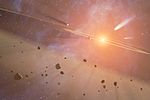Wikipedia:Today's featured article/February 14, 2017
Epsilon Eridani is a star in the constellation of Eridanus. Viewable from most of Earth's surface along a declination 9.46° south of the celestial equator, it is 10.5 light-years away and has an apparent magnitude of 3.73. It is the third-closest individual star or star system visible to the unaided eye. Estimated at less than a billion years old, the young star has a higher level of magnetic activity than the present-day Sun, with a stellar wind 30 times as strong. Epsilon Eridani is smaller and less massive than the Sun, with a greater proportion of hydrogen and helium. It is a main-sequence star of spectral class K2, which means that energy generated at the core through nuclear fusion of hydrogen is emitted from the surface at a temperature of about 5,000 K, giving it an orange hue. Observations for more than twenty years have yielded evidence of a giant planet orbiting the star, making it one of the nearest systems with a candidate exoplanet. The detection of this planet, Epsilon Eridani b, was announced by Bruce Campbell, Gordon Walker and Stephenson Yang in 1987. (Full article...)
